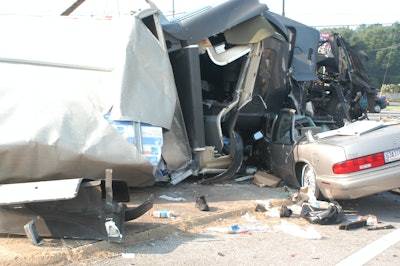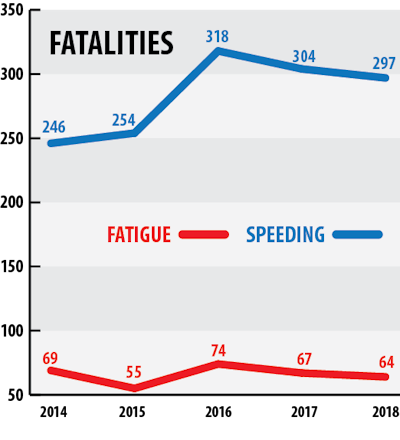 A rise in truck-related fatalities in 2018 doesn’t automatically mean ELDs were to blame.
A rise in truck-related fatalities in 2018 doesn’t automatically mean ELDs were to blame.When the National Highway Traffic Safety Administration released its 2018 data this fall, some entities saw an excuse to trot out the ELD punching bag. They use two big-picture trends to claim that the electronic logging device mandate, in its first full year during 2018, was a cause of higher truck-related fatalities. After all, overall highway deaths dropped 2.4% in 2018, while truck-related fatalities rose.
But not so fast.
First, consider two other broad numbers. Large-truck-related fatalities rose almost 5% in 2017, but during 2018, that yearly increase slowed considerably to under 1%. No fatality increase is good, but the trend moved significantly in the right direction while under the mandate.
 The number of fatal large-truck accidents involving speeding or fatigue in 2018, seen in the context of recent years, doesn’t back up the alleged link between ELD use and large-truck-involved fatalities. The records are compiled by the National Highway Traffic Safety Administration.
The number of fatal large-truck accidents involving speeding or fatigue in 2018, seen in the context of recent years, doesn’t back up the alleged link between ELD use and large-truck-involved fatalities. The records are compiled by the National Highway Traffic Safety Administration.There’s more specific data, too. As ELD-fatality theorists rightly argue, ELD’s strict time accounting causes some drivers to rush more, forcing their fractured schedules into the flawed hours of service template. By this rationale, excessive speeding would be a major factor in truck-related deaths.
This increased stress to make the most of on-duty hours under Big Brother’s unforgiving eye includes the diminished scheduling flexibility that often precludes grabbing a nap. So presumably 2018 also would have seen an increase in fatigue as a factor in large-truck-related crashes.

Was that the case? No. NHTSA’s same data set shows the trend for fatal accidents where the truck driver was at fault and speeding was a factor. It does the same where fatigue, instead of speeding, was a factor. In both cases, fatalities dropped from 2016 to 2017, a year when some of the largest fleets were already using ELDs and the rest were adopting ahead of the December 18, 2017, deadline.
Fatalities dropped again in those categories again in 2018.
Or look at the drivers of large trucks involved in one-vehicle fatal accidents. Where fatigue was a factor for that group, fatalities dropped from 41 in 2017 to 35 in 2018, a 15% decline. Change that factor to speeding and the numbers, though rising erratically from 2009 to 2016, dropped in 2017 and again in 2018.
When I asked NHTSA about its data supporting the ELD-fatality theory put out by some groups, a spokesman said, “We would not have any data to back up what other organizations are saying.”
No surprise. To establish a clear link between ELD use and fatalities, the burden of proof is on whoever makes the allegation. If anything, the underlying numbers weigh against that conclusion.
Furthermore, as has been argued in this space and elsewhere, the unsafe operating conditions created by the hours of service rule are due primarily to the rule itself, not the device used to measure those hours. DOT’s pending hours reform is expected to alleviate those adverse conditions.










